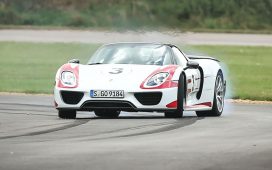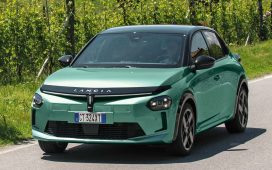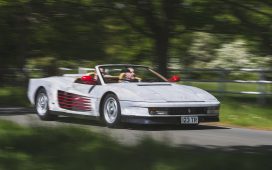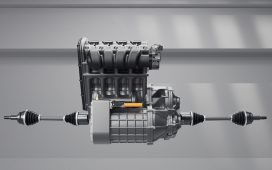Hyliion founder and CEO Thomas Healy discusses the properties of the Hypertruck ERX electric powertrain at the 2023 Management Conference & Exhibition in Austin, Texas, on Oct. 14. (John Sommers II for Transport Topics)
[Stay on top of transportation news: Get TTNews in your inbox.]
AUSTIN, Texas — Hyliion Holdings Corp. showcased its electric powertrain technology Oct. 14 during a ride-along at American Trucking Associations’ Management Conference & Exhibition.
The Hypertruck ERX used in the demonstration is a range-extended electrified powertrain. Hyliion showed how its integrated solutions work during the ride-along session. The Peterbilt Model 579 sleeper used in the demonstration drove around for about 15 minutes after leaving a staging area outside the Austin Convention Center.
“It’s Day 1 of MC&E,” Hyliion CEO Thomas Healy said after the ride. “Our headquarters is just 20 to 30 minutes away, just up the road. So, it’s great to be in our hometown showcasing our technologies, and we’ve already had numerous fleets out coming to check out the vehicle, and we have meetings and ride-and-drives planned throughout the week here.”
Healy added those fleets are looking to see if the powertrain system can work for their operations. It was designed around the limitations of electric vehicle technologies with its integrated power sources. The truck is primarily fueled by natural gas that then also charges the battery. These systems are further complemented by a natural gas range extender.
A Peterbilt Model 579 sleeper with the Hyliion Hypertruck ERX electric powertrain is seen outside the Austin Convention Center in Austin, Texas. (John Sommers II for Transport Topics)
“The truck, the chassis, all of that comes from Peterbilt. The drive system, the drivetrain, is developed by Hyliion,” Healy said. “So, very similar to most other EVs, you’ve got your battery pack, you’ve got your dual e-axles on the rear of the truck. But what makes this unique is you have the natural gas engine under the hood that’s sitting there and charging the batteries as you go.”
Healy pointed out that with a normal electric truck, the fleets have to adjust for infrastructure limitations. He noted they have to find charging options where they operate, they have to figure out how long the truck takes to charge and how much range it has. The natural gas focus of the powertrain is designed to give fleets flexibility and options as they work to reduce emissions.
#Hyliion and @Cummins Receive Certification from #CARB/@AirResources for the #HypertruckERX #Electric Powertrain.
Proud of this milestone on the path to commercialization!https://t.co/lbCEol9vjQ pic.twitter.com/8lkPchv7AR
— Hyliion (@Hyliion) September 18, 2023
“The goal is you refuel it with natural gas, and that natural gas is what produces the electricity that charges up the battery pack. So, the battery gives you about 75 miles of EV range, but then when you have the generator under the hood, the total vehicle range is up to 1,000 miles.”
The truck was driven by a technician who started out the ride-along by going over the startup process. It was similar to starting up a diesel-powered truck with the exception of an extra systems pre-check beforehand. The technician started the process by turning his key in the ignition on one click. The dashboard display then alerted the technician that it was ready with a green icon. That display screen also showed a variety of basic vehicle and engine readings.
Trimble CEO Rob Painter discusses the company’s continued investment in the freight transportation industry and its vision for a more connected supply chain. Tune in above or by going to RoadSigns.ttnews.com.
The truck then departed from the staging area on Cesar Chavez Street. It didn’t come across much in the way of obstacles with the weather being clear and traffic being mild. There were some areas of rough road conditions as well as construction, though they were easily navigated.
The technician took advantage of the lighter traffic to demonstrate the truck’s capabilities. He showed how well it was able to accelerate and brake. The handling during normal driving as well as acceleration and braking felt smooth from the passenger seat. The engine also was quiet, as would be expected with electrified systems, even with its solutions being integrated into an existing truck.
The natural gas range extender in the engine is an electric motor that essentially is used as a generator. The internal combustion e
ngine can feed the power into the generator to help produce more power instead of having a transmission that feeds power back to the axles.
“That’s a motor that we actually use as a generator,” Healy said. “So, the internal combustion engine is spinning, and that motor is producing electricity and that’s what feeds the battery pack.”
The Hypertruck ERX still has the option to recharge like a regular electric truck. The charging port is behind a panel near the passenger side door. But with that option the system is able to qualify for some emission-reduction credits. Healy notes, though, that interest has been primarily on the natural gas aspect of the power systems.
“If they’re operating in an area where there is charging infrastructure and they can get access to low-cost electricity, then sure, plug it in overnight,” Healy said while opening the panel. “When the battery gets low, then rely on the natural gas and come back with an empty battery and plug it in overnight again. But what most fleets are saying is they want to avoid that infrastructure cost. So, they won’t set up the charging infrastructure.”










